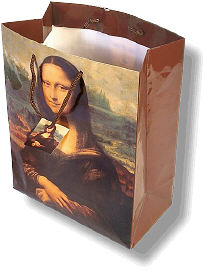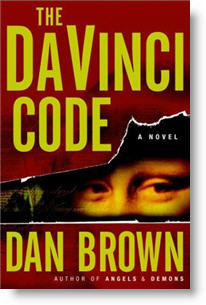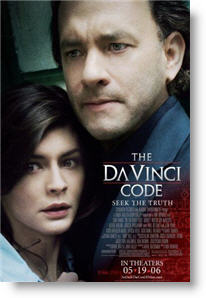Is The Da Vinci Code “the most serious assault against Christianity”?

It is no secret that Christianity in the USA, UK and other nations is increasingly under fierce attack in the media, in schools, in the courts and, all too often, even in churches. In a culture that systematically seeks to discredit Christ and His Word, theologian (and Chicago-area pastor) Dr. Erwin Lutzer has made this observation: “The Da Vinci Code is the most serious assault against Christianity that I have ever witnessed.”[1]
In light of such a bold statement, let us take a closer look at Dan Brown’s immensely popular novel, the soon-to-be-released movie of the same name and their possible impact on the church and culture.
The novel

Although Dan Brown would have us believe that “all descriptions of artwork, architecture, documents, and secret rituals in this novel are accurate,”[2] The Da Vinci Code is a work of fiction, complete with good guys, bad guys and narrow escapes. Its protagonist, Harvard cryptologist Robert Langdon, is a fairly passive character with little complexity. Also, the novel’s plot twists are predictable at best, and the writing, although occasionally quite good, is unmemorable. It is passably entertaining as “popular” fiction,[3] but hardly the type of novel that would stand the test of time to become a classic. And yet, The Da Vinci Code has become a worldwide sensation.
The great draw to this otherwise unremarkable novel is its central conspiracy theory, which, very simply put, sees Jesus married to Mary Magdalene. After Jesus’ death, Mary then supposedly fled with their child and became, over time, a symbol of the “sacred feminine” of ancient paganism.
This theory is hardly new to Dan Brown; any serious student of ecclesiastical history will be familiar with this ancient (albeit aberrant) tradition, which has long been held as heresy by Catholics and Protestants alike.[4] However, one need only delve (and not even very deeply) into the “historical” basis for this tradition to be convinced that it is, indeed, fiction.
Michael Baigent, Richard Leigh and Henry Lincoln[5] make this startling admission concerning their own research:
We sought only to winnow through [the Gospels] — to locate certain fragments of possible or probable truth… fragments that might attest to a marriage between Jesus and the woman known as the Magdalen. …In order to find them, we realized, we would be obliged to read between lines, fill in certain gaps, account for certain caesuras and ellipses. We would have to deal with omissions, with innuendos, with references that were, at best, oblique. [6]
But the assault against Christ and His Word, the Bible, in The Da Vinci Code runs much deeper than the mere rehashing of an ancient conspiracy theory. By planting seeds of doubt in the reader’s mind concerning how the Bible came into existence, the novel—and presumably the movie as well—becomes a direct assault against the authority of Scripture. According to Mr. Brown’s fictional historian, Leigh Teabing,[7] the Roman Emperor Constantine picked through the ancient gospels and chose the ones that suited his political agenda, thus creating what we now have as the Bible, while willfully suppressing other, more viable, documents.[8] (In reality, the canon of Scripture was not put forth at a church council until after Constantine’s death—the Nicene Council of Constantine’s day was much more concerned with the deity and nature of Christ.) Brown’s “fictional” history lesson is pseudo-academic chicanery that has been repeatedly refuted by historical and biblical scholars.[9]
The book mentions Leonardo Fibonacci di Pisa, a thirteenth-century mathematician who discovered a series of numbers with a very curious quality.
Fibonacci’s sequence begins with zero, then one, then each subsequent number is the sum of the two previous numbers (0, 1, 1, 2, 3, 5, 8, 13, etc.). After the first several numbers, the ratio between any two numbers in the sequence is 1.618 (i.e., the second number is 1.618 times greater than the previous number).
What makes this discovery so significant, and how does it relate to the creation/evolution controversy? The ratio 1.618, known by the ancient Greeks as the Divine Proportion or Golden Ratio, is found virtually everywhere, both in nature and in art, music and architecture. It appears in spirals such as pinecones, pineapples, seashells, horns, sunflowers and many others; it is the ratio between each of our finger bones, arm bones and leg bones. The number of leaves or petals on a plant is often a Fibonacci number; this is why a flower with five petals is more pleasing to the eye than one with four petals.
Our perception of beauty is very often (unconsciously) based on the ratio 1.618. Knowing this, composers and artists—including Leonardo da Vinci—frequently base their works on the Divine Proportion. While many of Brown’s assertions concerning this phenomenon are questionable or outright false,* the ubiquity of the Divine Proportion, or phi, in nature is well documented. It is difficult to imagine a more powerful evidence for design, although Mr. Brown’s fictional characters draw the wrong conclusion.**
* Brown’s assertion, for example, that the ratio of female to male honeybees in “any beehive in the world” is phi; Brown, p. 94.
** “When the ancients discovered PHI, they were certain they had stumbled upon God’s building block for the world, and they worshipped Nature because of that.” Brown, p. 95.
Ideally, only the very naïve will be taken in by such assertions made in a work of fiction; the sad truth, however, is that much of the population is already very naïve concerning the Word of God, and worse, many are desperate for an excuse not to believe and obey it.[10] For them, the cleverly presented falsehoods in The Da Vinci Code will be all the justification they need to continue to deny the authority of the Bible.
Ironically, it is in this context that many readers will first be introduced to the fascinating topic of the “Fibonacci Sequence and Divine Proportion.” See the sidebar for more about this remarkable evidence that supports creation, not evolution.
The assault
Is Pastor Lutzer, then, correct to label The Da Vinci Code as “the most serious assault against Christianity” of our time? In a sense he has come close to the truth, for the greatest attack against Christianity and Jesus Christ is, and has always been, the purposeful assault against His Word. However, in this war, The Da Vinci Code is only a small cog in a much greater wheel. How many theologians and Christian leaders find themselves up in arms against a mediocre work of fiction, while continuing to teach that God’s Word can’t be trusted in all 66 books, especially Genesis? The Da Vinci Code will someday go quietly out of vogue, while generations of Christians continue down that slippery slope of unbelief that begins with compromise. It is on this battleground that the real war is being waged.
Whether or not a believer chooses (with discretion) to read The Da Vinci Code or watch the upcoming movie, it remains imperative to be informed of all aspects of the assault against the Word of God—whatever form it takes—and to “be prepared to give an answer” (1 Peter 3:15) in order to gently and intelligently overcome any obstacle to the gospel of Jesus Christ.
Author: Melinda Christian, Answers in Genesis USA
References and notes
- As quoted on CNN, March 28, 2006. Return to text.
- Dan Brown, The Da Vinci Code (New York: Doubleday, 2003) p. 1. Return to text.
- As opposed to fiction that is classified as “literary”; a distinction used by publishers and authors. Return to text.
- I first encountered this theory while studying New Testament at a Bible college; I encountered it a second time in another work of fiction that predates The Da Vinci Code by several years. Return to text.
- Authors of Holy Blood, Holy Grail Delacorte Press, 1982; Baigent and Leigh recently lost a lawsuit against Brown over copyright infringement. Return to text.
- As quoted on equip.org. Return to text.
- Teabing is an anagram of Baigent. It is ironic that Brown chose to name his “expert” after Michael Baigent and Richard Leigh, who recently brought litigation against him (see footnote 5). Return to text.
- Brown, pp. 231-235. Return to text.
- Many excellent articles and books are available that soundly refute the claims made by Dan Brown. One particularly helpful resource was The Real History Behind The Da Vinci Code by (secular) historian Sharan Newman, Berkeley Books, New York, 2005. However, please use this—and all tools—like the Bereans (Acts 17:11). Return to text.
- Romans 1:25. Return to text.
Text copyright © 2006, Answers in Genesis USA, All Rights Reserved — except as noted on attached “Usage and Copyright” page that grants ChristianAnswers.Net users generous rights for putting this page to work in their homes, personal witnessing, churches and schools. Illustrations and layout copyright, 2006, Films for Christ.
Additional relevant information
- Christian Spotlight movie review page: The Da Vinci Code
- The Da Vinci Code Message (online audio) by Christian Answers team member, Ray Comfort (Living Waters / Way of the Master)
- Was Jesus Christ only a legend? Answer
- Is Jesus Christ a man, or is he God? Answer
- If Jesus is God, how could he die? If Jesus died on the cross, then how can he be alive today? Answer
- Was Jesus Christ God, manifest in human form? Answer
- Is Jesus Christ really God? Answer
- If Jesus was the Son of God, why did He call Himself the Son of Man? Answer
- Trinity—How can one God be three persons? Answer
- Character—Is Christ's character consistent with his high claims? Answer
- Has science disproved the miracles associated with Jesus Christ? Answer
- Could Christ have sinned? Answer
- Archaeology—Have any burial sites been found for the people involved in Christ's life and death? Answer
- Mary Magdalene
- How do we know the Bible is true? Answer
- How can the Bible be infallible if it was written by fallible humans? Answer
- “The Jesus Seminar”—Are their criticisms of the gospels valid? Answer
- “The Jesus Seminar”—Who do they really speak for? Answer





